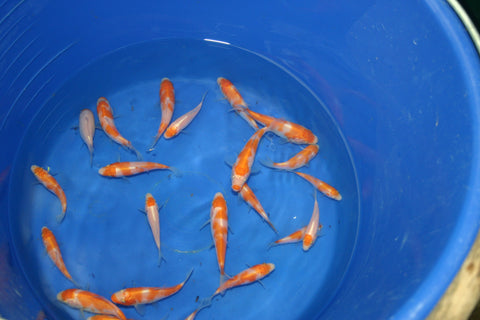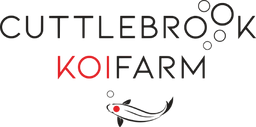This article was first written for and published by Koi Carp Magazine in 2008
5th May is “Boys’ Day” in Japan and it is also the time when traditionally, the Koi spawning season starts. This is a tradition which we have also followed most years and this year was no exception. One of the parent sets that we spawned on 5th May this year was Kohaku and we used a female from Hoshikin and two males that we bred ourselves and which came from a Momotaro and Matsunoske cross that we did a few years ago.
After spawning, the eggs take about three days to hatch and then a further three days for the fry to swim up and take their first gulp of air. After this has happened they are ready to be released into a mud pond where they are grown until they are around 2.5 cm in length and ready for first selection. At first selection we keep around 10 per cent, usually around 3000, baby Koi to go back into the mud pond for about another month before we harvest them again. It is this second harvest that this article follows.
This is very much a family business and whilst I am usually stuck in the office dealing with enquiries and all the boring paperwork, I do get involved when it comes to harvesting and selection. Selection is at the very core of our business and the decisions we make, about what to keep and what to reject, will affect our business for years to come. Each new parent set will produce slightly different offspring and Mark and I both use our years of experience at selection to predict how the baby Koi are likely to develop. Our youngest son Bryn, who is 11, is very keen to be involved in the business too and helps out around the farm when he can so that he can learn every aspect of farming Koi. Today, Bryn pitched in to help with the harvest which left me free to take photographs! Of course, I can’t continue without mentioning Mark Griffiths who has worked for us since he began helping out on Saturdays at the age of 15 and has worked full time for us for almost 18 months now. Over the years young Mark has become a key member of our team and is very much like part of the family.
Early in the morning at the start of August Mark decided that the Kohaku were ready for second selection. In our first article we showed how when harvesting a mud pond the net is stretched from one side of the pond to the other and slowly dragged from one end to the other. Over the years we have developed a technique that ensures the well being of the Koi that we harvest and makes sure that we catch as many as is possible at each harvest. When the net is being pulled up the bank of the mud pond it is important to make sure that the baby Koi do not get caught in the folds of the net. Mark (Davis) stays in the water, keeping the lead weights along the bottom of the net as close the ground as possible as it is pulled in. Mark (Griffiths) slowly pulls the top of the net which floats on the surface of the water in, at the same time, whilst Bryn takes the lead line from his father and pulls it, and the middle of the net, onto the bank, helping to make sure that the net is kept as wide and flat as possible.

Pulling in the net Kohaku harvest 6 Aug 08
Once this has been done, all the Koi are caught up and safely held in the net.

All rounded up
These Koi are then transferred, using a pan net, into a bucket and placed gently into the transport tank. Even this process is carried out with the greatest of care and here you can see that as Bryn places the Koi into the tank, he isn’t pouring them out but is releasing them slowly by inverting the bucket so as to cause as little stress as possible.

Bryn with transport tank 6 Aug 08 Kohaku
The Koi are carried in the transport tank back to the selecting tanks and then a second harvest of the same mud pond is carried out. This is a good way of gauging the effectiveness of our harvesting technique as if we’ve done the job properly the first time we won’t catch very many second time round!
It’s already clear to see the difference in size between the Koi in this harvest and the last time they were harvested a few weeks ago. They are now 5 – 7.5 cm in length and some are even bigger! There are far fewer for us to select through than there were at first harvest and instead of taking us two long days to sort through them all, it can be comfortably done in just one day.

Selecting the best
We are looking for good body shape, good skin quality, a white nose and tail and good contrast between the red and white as well as a balanced pattern. The difference in growth rates between Koi from the same spawning can be quite remarkable and it is apparent amongst these keepers. It is not our aim however to keep the faster growing Koi as growth rate has nothing to do with quality and it is quality that we are aiming for. Amongst them you may spot some Tancho Kohaku which are also produced when breeding Kohaku. These are actually quite rare and to find one with a perfect Tancho spot even more rare. Such a Koi, with good body shape and skin quality, is unlikely to be sold small and can command a high price when they do eventually go up for sale.
Here is a picture of the Kohaku that we kept after the first harvest and also a picture of some of the keepers from the second harvest using the same bucket. As you can see, they are much bigger now and the colour is deeper and the pattern easier to see.

Cuttlebrook Kohaku after first selection July 08

Kohaku after second selection 6 Aug 08
After this second harvest was carried out we returned around 450 to the mud pond and the remainder were re-graded and moved to a sales tank. Each year our selection process gets tighter – the less Koi that we put back into the mud pond, the better the growth rate is likely to be. We have to find a balance between optimum growth rate and quality. We would rather keep a smaller number of higher quality Koi, that will have the opportunity to grow well, than to keep a higher number of less promising Koi to make up the numbers.
When we are carrying out selection, people always ask us what we do with the ones that we don‘t keep. Well, the answer is simple, each time we carry out selection on a pond of Koi, the ones we don’t keep are sold. Basically, we don’t have enough space on the farm to grow on every Koi that we produce and so we have to choose those that we feel have the best prospects for the future to grow on. Those that we sell are simply those for whom the future is not so certain in terms of development. It doesn’t mean that they aren’t nice Koi just that they are less likely to become a show winner than the ones that we keep to grow on. As a hobbyist, you could spend a reasonable amount of money on a selection of baby Koi and take the time to grow them on to see if any of them turns into something special, or you could spend the same amount of money on a much larger Koi that we have grown on and is that price because it is special.
Each Koi on the farm goes through a selection process at least twice a year until the day it is sold, so for a Koi to make it past two years of age and to still be growing on here, it must be something really special! This year we had a total of around 80 Koi that were two and three years old at the start of the summer growing on in one of our mud ponds – that’s 80 Koi chosen from over 1 million that made it to first selection size. That’s a lot of selecting and some very special Koi!
This Tancho Kohaku went on to win second place in Tancho class at size four at the BKKS National 2008.

This Kohaku has an unusual pattern referred to as “Inazuma” which means “lightening”. It also went on to win second place in Kohaku at size four at the Festival of Fish Keeping in 2007.


